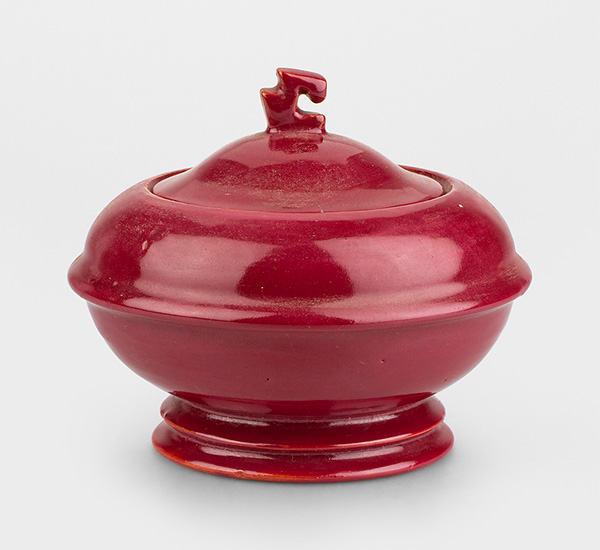
Pottery by Thagouhi Beer-Zorian in CERAMICA CH
Roland Blaettler, 2019
Thagouhi Zorian (Plovdiv, Bulgaria, 1901 – Geneva, 1982) was the daughter of Stepan, also known as Rostom, Zorian (1867–1919), one of the three founders of the Armenian Revolutionary Federation, a socialist movement established in Tiflis in 1890 which campaigned for Armenian emancipation within the Ottoman Empire. In 1914, Thagouhi was brought by her mother Elisabeth to Geneva, where she studied under Eugène Gilliard at the University of Applied Sciences and Arts (artzakank-echo.ch). In 1923, she married the painter and engraver Charles Richard Beer (born in 1892). Thagouhi and Charles opened a shop on Grand’Rue in the historical centre of Geneva, where they offered their artworks for sale.
Thagouhi was a painter, preferably in batik and on pottery (mainly on faience). At the 1922 National Exhibition of Art in Lausanne and a year later at an exhibition curated by the Gesellschaft Schweizer Malerinnen, Bildhauerinnen und Kunstgewerblerinnen (Swiss Society of Female Painters, Sculptors and Craftswomen) in Geneva, she exhibited batik works only. As a member of L’Œuvre, the French-speaking section of the Schweizerischer Werkbund, she regularly participated in the exhibitions staged by the organisation from 1926 onwards. She usually showed pottery and batik works. In 1959, she entered a few pieces at an exhibition of contemporary Swiss pottery curated by the Geneva Museum of Art and History and in 1961, she provided five batik and five ceramic works for the exhibition “Eugène Gilliard et ses élèves” (Eugène Gilliard and his students) (Gilliard 1961, nos. 41–50). Until the early 1970s, she continued to exhibit ceramic works, both under the auspices of the Female Painters, Sculptors and Craftswomen, and of the Mutuelle des Artistes Genevois.
Beer-Zorian was friends with Edith Duflon, whom she apparently met while attending Gilliard’s courses. For a while they shared a studio which Duflon had set up in 1925 in La Muraz, her father’s estate in Villeneuve. It is possible that it was at Duflon’s side that Beer-Zorian was introduced to the art of faience painting.
The colours of the glazes that Beer-Zorian used at La Muraz between 1925 and 1930 were deep and bold and were similar to those used by her colleague (MHL AA.VL 2002 C 5508-15; MHL AA.VL 2002 C 5508-54). The vessels themselves were designed and created by others (see also Edith Dusserre-Duflon). Duflon and Beer-Zorian had their own stand at SAFFA, a large Swiss exhibition of women’s works staged in Bern in 1928; they had it especially designed for the occasion by an architect and fitted with a sign that read “La Muraz – Poterie artistique” (SAFFA 1928, exhibitor no. 1303).
Beer-Zorian’s later works, mainly in faience, were generally characterised by a softer colour palette, often with watery hues. The figures and flower motifs were drawn freehand with shapes that sometimes bordered on the amateurish (MHL AA.MI.1744; MHL AA.MI.1659 – Musée Ariana, Inv. AD 0418; AD 1235; AD 1236; AD 1237; AR 11479; AR 11498; AR 11499).
In a piece on an exhibition curated by the Mutuelle des Artistes Genevois in 1925, the well-known art critic Lucienne Florentin praised Beer-Zorian’s talent when it came to her batik work (“Mrs. Beer-Zorian should focus her attention on the batik technique”) but expressed mild criticism with regard to her ceramic work: “flowing colours, a little decorative confusion, warm and sometimes deep shades, quite a pleasing material, a fertile imagination and manual liveliness” (La Suisse dated 28th November 1925, p. 1).
Beer-Zorian’s mark is basically composed of two triangles side by side and the letters “TB / ZORIAN” (MHL AA.MI.1744).
Translation Sandy Haemmerle
Sources:
Artzakank, bimonthly bilingual journal in French and Armenian published in Geneva (artzakank-echo.ch. – accessed in May 2019)
References:
Gilliard 1961
Eugène Gilliard et ses élèves. Exposition commémorant le centième anniversaire de la naissance de l’artiste. Catalogue d’exposition, Musée Rath. Genève 1961.
Saffa 1928
Saffa. Schweiz. Ausstellung für Frauenarbeit – Exposition nationale suisse du travail féminin. Catalogue principal. Berne 1928.

